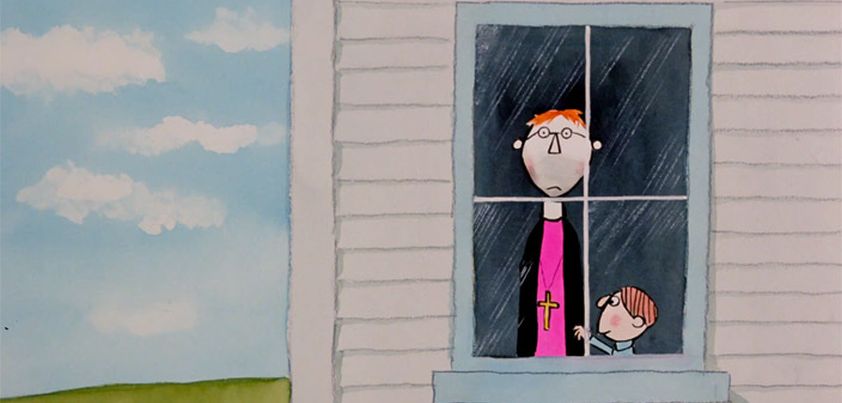 Stephen Leacock’s The Awful Fate of Melpomenus Jones takes a sarcastic look at the themes of shyness and polite social conventions. Many readers mistakenly associate Melpomenus’s refusal to give a false reason to leave the house with his being a clergyman. Not so! In the introduction, we are told the young curate was too modest (shy) to tell a lie. His downfall is because of shyness, not honesty. The absurd outcome is as much the over-polite hosts’ fault as it is Melpomenus’s. If anyone was responsible for his spirit rushing from the house like a hunted cat, it was them. More…
Stephen Leacock’s The Awful Fate of Melpomenus Jones takes a sarcastic look at the themes of shyness and polite social conventions. Many readers mistakenly associate Melpomenus’s refusal to give a false reason to leave the house with his being a clergyman. Not so! In the introduction, we are told the young curate was too modest (shy) to tell a lie. His downfall is because of shyness, not honesty. The absurd outcome is as much the over-polite hosts’ fault as it is Melpomenus’s. If anyone was responsible for his spirit rushing from the house like a hunted cat, it was them. More…
Rules of the Game
 The title of this story by Amy Tan refers to both the game of chess and the game of life. A Chinese-American mother’s term for one important rule is the art of invisible strength (self-control). The story deals with a number of themes: poverty, respect (for parents, others and one’s cultural heritage), pride vs. humility, passion and dedication, and mother/daughter relationships. At the end of the story, both fail in exercising the art of invisible strength. The mother’s understandable pride leads to bragging; the daughter’s response is rudeness and running away. Whose wind (willpower) will blow the strongest? More…
The title of this story by Amy Tan refers to both the game of chess and the game of life. A Chinese-American mother’s term for one important rule is the art of invisible strength (self-control). The story deals with a number of themes: poverty, respect (for parents, others and one’s cultural heritage), pride vs. humility, passion and dedication, and mother/daughter relationships. At the end of the story, both fail in exercising the art of invisible strength. The mother’s understandable pride leads to bragging; the daughter’s response is rudeness and running away. Whose wind (willpower) will blow the strongest? More…
Zita
 There are two Zitas in this romantic coming of age story by Arturo B Rotor. The first is the woman who caused a broken-hearted young man to seek solace teaching on Anayat, an off-the-grid Philippine island of broken cliffs and coconut palms; the second, an adolescent Anayat schoolgirl who he agrees to teach how “to be a lady”. As sometimes happens, schoolgirl Zita develops a crush on the teacher. When he leaves in the hope of reconciling with his former love, she comes to understand something he once told her. Themes: unrequited love, alienation, depression, teenage infatuation. More…
There are two Zitas in this romantic coming of age story by Arturo B Rotor. The first is the woman who caused a broken-hearted young man to seek solace teaching on Anayat, an off-the-grid Philippine island of broken cliffs and coconut palms; the second, an adolescent Anayat schoolgirl who he agrees to teach how “to be a lady”. As sometimes happens, schoolgirl Zita develops a crush on the teacher. When he leaves in the hope of reconciling with his former love, she comes to understand something he once told her. Themes: unrequited love, alienation, depression, teenage infatuation. More…
A Cup of Tea
 Although written in a lighthearted tone, this innocently titled story from Katherine Mansfield deals with some big issues. Its major theme is the materialism, hypocrisy and vanity of the British upper class. The desire for a “cup of tea” symbolizes the one similarity (womanhood) between a young beggar and middle-aged socialite. One is poor, desperate and astonishingly pretty; the other rich, entitled and not exactly beautiful. The socialite’s reason for wanting to help the girl was to show how compassionate she is. However, she soon realizes this may highlight a less favorable difference between them. Other themes: appearance, jealousy, insecurity. More…
Although written in a lighthearted tone, this innocently titled story from Katherine Mansfield deals with some big issues. Its major theme is the materialism, hypocrisy and vanity of the British upper class. The desire for a “cup of tea” symbolizes the one similarity (womanhood) between a young beggar and middle-aged socialite. One is poor, desperate and astonishingly pretty; the other rich, entitled and not exactly beautiful. The socialite’s reason for wanting to help the girl was to show how compassionate she is. However, she soon realizes this may highlight a less favorable difference between them. Other themes: appearance, jealousy, insecurity. More…
Cinderella
 Cinderella, perhaps the world’s best-known children’s story, has its origins in folklore. The version immortalized by Disney was first published in Charles Perrault’s 1697 book Stories or Tales from Times Past, with Morals, also known as Tales of Mother Goose. (Yes, Mother Goose was a man!) There are said to be over 1,000 variants of the story across the world. Perrault took the original framework, which has been around since the days of the pharaohs, and added the three elements for which his version is famous today: a fairy godmother, a pumpkin-carriage, and glass slippers. More…
Cinderella, perhaps the world’s best-known children’s story, has its origins in folklore. The version immortalized by Disney was first published in Charles Perrault’s 1697 book Stories or Tales from Times Past, with Morals, also known as Tales of Mother Goose. (Yes, Mother Goose was a man!) There are said to be over 1,000 variants of the story across the world. Perrault took the original framework, which has been around since the days of the pharaohs, and added the three elements for which his version is famous today: a fairy godmother, a pumpkin-carriage, and glass slippers. More…